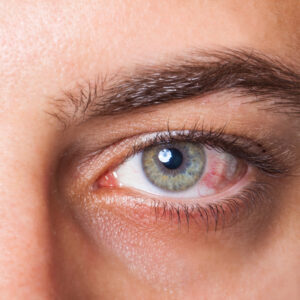During 2020 we learned more about the effects of coronavirus than any other topic. It has been the main subject on the news, social media, and of scientific research since January 2020. As the months flew by, it seemed like some additional short- or long-term effect of the virus was discovered every other week.
One of the main issues that accompany the novelty of COVID-19 is trying to understand its clinical presentations, since the symptoms and their intensity may vary from person to person. The primary COVID-19 symptoms are fatigue, cough, shortness of breath, loss of taste and smell, body aches, headaches, sore throat, nausea or vomiting, diarrhea, and fever. Among the additional symptoms reported is conjunctivitis. Conjunctivitis as a sign of coronavirus infection has been reported early in the course of the disease and also upon hospitalization.2 Conjunctivitis caused by COVID-19 has been a recent study of interest to determine if the eyes could represent a site of entry and transmission of viral particles.

The Ocular Effects of COVID-19
The ocular effects of coronavirus have not been fully quantified to date, and the role of the eye in this viral infection is still not understood. There is variability in the results found regarding conjunctivitis in infected patients.
A systematic review in which the data collected included 2,347 patients diagnosed with COVID-19 showed that ocular manifestations were present in 11% of patients. Those manifestations in the eyes included follicular conjunctivitis, ocular pain, discharge, and redness.2 Similarly, a systematic review and meta-analysis found that out of all the studies included, patients with severe COVID-19 infection had an increased incidence of conjunctivitis when admitted to the hospital, where 11.2% of patients reported ocular symptoms, the most common being conjunctivitis.3 On the other hand, a study that included only 38 hospitalized COVID-19 patients, found a much higher percentage, in which 31.6% of patients had ocular manifestations consistent with conjunctivitis.4
Although there are differences between the rate of ocular symptoms occurring in patients with coronavirus disease, most of the studies demonstrate a relatively low rate in the occurrence of ocular involvement, especially in comparison to primary symptoms, like fever and cough.
One question that remains unanswered is whether the ocular presentations are caused by infection of the ocular tissues with COVID-19, or if they are just a result of the flu-like symptoms that occur with viral illnesses. Several studies have showed that the presence of viral RNA from tears and conjunctival swabs was uncommon, but it is still unclear if the viral RNA found in the eyes could be a potential route of transmission for the disease.2,3,5
As suggested by the title of this article, another important question regarding the ocular symptoms of COVID-19 is whether or not conjunctivitis could be a predictor of the severity of the infection. The data has revealed that 6.91% of patients that have ocular abnormalities also suffer from pneumonia, suggesting that conjunctivitis may be more common in patients that have a severe coronavirus infection.2
Distinguishing COVID-19 Red Eye From Other Forms of Conjunctivitis
It seems as if this virus will accompany us until there is an extensive distribution of vaccines, and more research is obtained to fully understand the pathogenesis of COVID-19. For that reason, eye doctors need to distinguish the ocular signs and symptoms of COVID-19 from other causes of conjunctivitis.
The red-eye associated with coronavirus resembles adenoviral conjunctivitis and shares the following signs: follicular reaction, conjunctival hyperemia, and discharge.2,5 However, a difference that has been noted between these two types of conjunctivitis is that COVID-19 conjunctivitis is predominantly unilateral, unlike adenoviral conjunctivitis, which tends to be bilateral.5 Another factor that could aid in the differentiation of these ocular diseases is that complications such as corneal infiltrates, membranes or pseudomembranes have not been linked to COVID-19 thus far.5

Lastly, coronavirus does not appear to cause inflammatory responses in the ocular surface. So far, subepithelial corneal infiltrates have not been reported in association to COVID-19, unlike in epithelial keratoconjunctivitis.4 These characteristics in addition to the patient’s case history will help differentiate coronavirus infection from other forms of viral conjunctivitis.
Treatments of conjunctivitis caused by COVID-19
The research up until December 2020 shows that coronavirus has a lower risk of causing keratoconjunctivitis in comparison with adenovirus, and most ocular symptoms in patients with COVID-19 were mild. For this reason, the injudicious use of corticosteroid drops is not recommended.3
The same methods of caution used to prevent the spread of coronavirus apply to the management of viral conjunctivitis; frequent hand washing, avoiding sharing personal items and avoiding rubbing or touching the eyes. However, since there is currently no proven treatment for ocular symptoms in COVID-19, further studies are required to determine what the best ocular treatment is for these cases of conjunctivitis.4
The recent data regarding the signs of coronavirus disease may assist eye doctors and healthcare providers to understand the ocular manifestations of COVID-19, thus aiding in its diagnosis, prevention, and management. Although conjunctivitis is estimated to be a symptom in some of the patients with COVID-19, it is not used as one of the main identifiers of the infection.
Further research of ocular manifestations is necessary to determine if the eye is a significant route for COVID-19 transmission, and to identify if eye protection is needed to slow the spread of the virus. Until additional information is provided regarding the infectivity of viral particles in the ocular surface, we must continue to be cautious and employ frequent hand washing and avoid touching the eyes and the face.
References
-
Symptoms of Coronavirus [Internet]. Centers for Disease Control and Prevention. Centers for Disease Control and Prevention; [cited 2020Dec27]. Available from: https://www.cdc.gov/coronavirus/2019-ncov/symptoms-testing/symptoms.html
-
Aggarwal K, Agarwal A, Jaiswal N, Dahiya N, Ahuja A, Mahajan S, et al. Ocular surface manifestations of coronavirus disease 2019 (COVID-19): A systematic review and meta-analysis. Plos One. 2020;15(11).
-
Inomata T, Kitazawa K, Kuno T, Sung J, Nakamura M, Iwagami M, et al. Clinical and Prodromal Ocular Symptoms in Coronavirus Disease: A Systematic Review and Meta-Analysis. Investigative Opthalmology & Visual Science. 2020;61(10):29.
-
Wu P, Duan F, Luo C, Liu Q, Qu X, Liang L, et al. Characteristics of Ocular Findings of Patients With Coronavirus Disease 2019 (COVID-19) in Hubei Province, China. JAMA Ophthalmology. 2020;138(5):575.
-
Güemes-Villahoz N, Burgos-Blasco B, García-Feijoó J, Sáenz-Francés F, Arriola-Villalobos P, Martinez-De-La-Casa JM, et al. Conjunctivitis in COVID-19 patients: frequency and clinical presentation. Graefe’s Archive for Clinical and Experimental Ophthalmology. 2020;258(11):2501–7.

